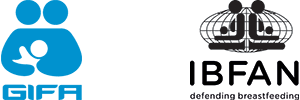
27/10/2023
“It is clear that any drug should only be used with caution in women who are or may become pregnant or breastfeeding, i.e., (1) by first assessing the possibility of dispensing with it, (2) by reserving it for well-established and well-documented indications, and (3) by ensuring adequate monitoring.” (quote frome Buclin T. et al, Médicaments, grossesse et lactation, Guide de prescription, 4e édition mai 2019)
Passage into breast milk
Overall, the passage into breast milk will be low if
- the product has a short half-life,
- it is highly bound to plasma proteins,
- has characteristics correlated with a low milk to plasma ratio,
- and if its oral bioavailability is low.
The level of exposure below which an impact on the child is unlikely is considered to be 10% of the maternal dose adjusted for weight. Another factor to consider is the age of the baby and its general health.
Find information
For parents and health care providers
- E-lactancia https://www.e-lactancia.org/ (en espagnol et anglais, simple avec codes couleurs)
- Le CRAT https://lecrat.fr (en français)
- Embryotox http://embryotox.de/einfuehrung.html (en allemand) le site le plus favorable à sauvegarder l’allaitement.
- LactMed https://toxnet.nlm.nih.gov/newtoxnet/lactmed.htm
- Association suisse de pharmacologie périnatale (ASPP) https://www.sappinfo.ch/fr/
- Médicaments, grossesse et lactation, Guide de prescription. Buclin T et al., 2019, 4e édition) https://boutique.revmed.ch/medicaments-grossesse-lactation-4e
- https://www.llli.org/breastfeeding-info/medications-quick-guide-parents/ (en anglais)
- LLL France documents sur les médicaments: https://www.lllfrance.org/vous-informer/fonds-documentaire/dossiers-de-l-allaitement/1472-da-62-medicaments-et-allaitement
- Exploration by search engine and prefering sites of Medical Journals (LactMed, pubmed, NCBI… )
ENTIS european network
- ENTIS réseau européen https://www.entis-org.eu/destiné à terme de diffuser des informations dans toutes les langues européennes. Knowledge bank (Conception), différentes lectures (patient et prof de santé)
- STIS Swiss Teratogen Information Service CHUV, membre d’ENTIS https://www.chuv.ch/fr/stis
- TIS UK Teratology Information Service Head of service Dr Kenneth Hodson (MBChB, MRCOG, MRCP (UK), MD) Address The Regional Drug and Therapeutics Center, 16-17 Framlington Place, Newcastle upon Tyne, NE3 5AN http://www.entis-org.eu/centers/newcastle-upon-tyne
- TIS Paris = CRAT Centre de Référence sur les Agents Tératogènes https://lecrat.fr
- TIS Lyon France http://www.entis-org.eu/centers/lyon Centre de Pharmacovigilance de Lyon, 162 Avenue Lacassagne 69424 – Lyon Cedex 03, France
- TIS Barcelona Clinical Pharmacology Service – Fundació Institut Català de Farmacologia (TIS Barcelona)
- TIS Madrid Servicio de Información Telefónica sobre Teratógenos Español (SITTE) – Service for health professionals http://www.entis-org.eu/centers/madrid
Different resources per country
France
- https://lecrat.fr
- LLL France documents sur les médicaments: https://www.lllfrance.org/vous-informer/fonds-documentaire/dossiers-de-l-allaitement/1472-da-62-medicaments-et-allaitement
- La rubrique « Le Coin du prescripteur » et la compilations de ces articles “Médicaments et allaitement – compilation des coins du prescripteur”. Édition 2016, en vente sur la boutique
- Les Dossiers de l’Allaitement, spécial hors-série 5ème JIA – La prescription de médicaments chez les mères allaitantes – Thomas Hale
- Feuillet Comment choisir un traitement pour une femme allaitante (Dr Jack Newman)
- Petit mémo des médicaments chez la mère allaitante
- DA n° 62 – Médicaments et allaitement
- DA, spécial hors-série 5ème JIA – La prescription de médicaments chez les mères allaitantes – Thomas Hale
- Feuillet Comment choisir un traitement pour une femme allaitante (Dr Jack Newman)
Belgium-Flanders / Netherlands
Canada
https://www.pharmacists.ca/education-practice-resources/patient-care/breastfeeding-resources/
Australia
https://www.nps.org.au/australian-prescriber/articles/drugs-in-breastfeeding-5
UK
https://www.sps.nhs.uk/articles/ukdilas/
https://www.breastfeedingnetwork.org.uk/drugs-factsheets
https://www.facebook.com/BfNDrugsinBreastmilkinformation/
USA
Dr. Thomas Hales’ Infant Risk Hotline and Website- https://www.infantrisk.com/
Lactmed, US National Institutes of Health’s Drugs and Lactation Database https://www.ncbi.nlm.nih.gov/books/NBK501922/
Medical imaging
In the case of medical imaging using contrast media, the widespread idea that breastfeeding should be stopped (often for 24 to 48 hours) is strongly questioned. For more information, please contact a specialised centre such as STIS Swiss Teratogen Information Service CHUV https://www.chuv.ch/fr/stis
